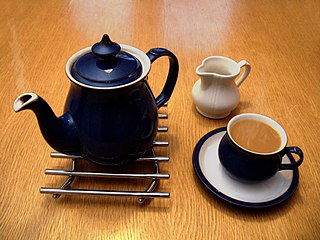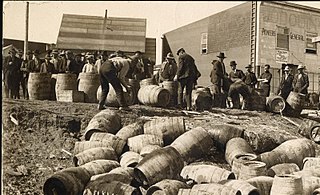
An alcopop is any of certain flavored alcoholic beverages with relatively low alcohol content, including:
- Malt beverages to which various fruit juices or other flavorings have been added
- Beverages containing wine to which ingredients such as fruit juice or other flavorings have been added
- Beverages containing distilled alcohol and sweet liquids such as fruit juices or other flavourings

A drink is a liquid intended for human consumption. In addition to their basic function of satisfying thirst, drinks play important roles in human culture. Common types of drinks include plain drinking water, milk, coffee, tea, hot chocolate, juice and soft drinks. In addition, alcoholic drinks such as wine, beer, and liquor, which contain the drug ethanol, have been part of human culture for more than 8,000 years.

Low-alcohol beer is beer with little or no alcohol content and aims to reproduce the taste of beer without the inebriating effects of standard alcoholic brews. Most low-alcohol beers are lagers, but there are some low-alcohol ales. Low-alcohol beer is also known as light beer, non-alcoholic beer, small beer, small ale, or near-beer.

Prohibition is the act or practice of forbidding something by law; more particularly the term refers to the banning of the manufacture, storage, transportation, sale, possession, and consumption of alcoholic beverages. The word is also used to refer to a period of time during which such bans are enforced.

Vodka is a clear distilled alcoholic beverage with different varieties originating in Poland and Russia. It is composed primarily of water and ethanol, but sometimes with traces of impurities and flavorings. Traditionally it is made by distilling the liquid from cereal grains that have been fermented, later on using potatoes though some modern brands use fruits or sugar as the base.

There is a long history of alcoholic drinks in China. They include rice and grape wine, beer, and various liquors including baijiu, the most-consumed distilled spirit in the world.

Alko is the national alcoholic beverage retailing monopoly in Finland. It is the only store in the country which retails beer over 5.5% ABV, wine and spirits. Alcoholic beverages are also sold in licensed restaurants and bars but only for consumption on the premises.

Prosecco is an Italian DOC or DOCG white wine produced in a large area spanning nine provinces in the Veneto and Friuli Venezia Giulia regions, and named after the village of Prosecco. It is made from the Prosecco grape but denomination rules allow up to 15% of the wine to be other permitted varieties. Prosecco is almost always made in sparkling or semi-sparkling style, but a still wine is also permitted. Within the larger designation are two small DOCG areas, Conegliano Valdobbiadene Prosecco in the hills between the towns of Conegliano and Valdobbiadene, and Asolo Prosecco around the nearby town of Asolo. Prosecco Superiore is always spumante and comes only from these DOCG areas.

Liquor is an alcoholic drink produced by distillation of grains, fruit, or vegetables that have already gone through alcoholic fermentation. The distillation process purifies the liquid and removes diluting components like water, for the purpose of increasing its proportion of alcohol content. As liquors contain significantly more alcohol, they are considered "harder" – in North America, the term hard liquor is used to distinguish distilled alcoholic drinks from non-distilled ones, whereas the term spirits is used in the UK.

Purposeful production of alcoholic drinks is common and often reflects cultural and religious peculiarities as much as geographical and sociological conditions.
An alcohol-free or non-alcoholic drink, also known as a temperance drink, is a version of an alcoholic drink made without alcohol, or with the alcohol removed or reduced to almost zero. These may take the form of a non-alcoholic mixed drink, non-alcoholic beer, and "mocktails", and are widely available where alcoholic drinks are sold.

Alcoholic drinks in Sweden are as common as in most of the western world. Sweden is historically part of the vodka belt, with high consumption of distilled drinks and binge drinking, but during the later half of the 20th century, habits are more harmonized with western Europe, with increasing popularity of wine and weekday drinking. Wine is now also grown and produced in several parts of Sweden and the southernmost region of Skåne is turning into a hub experiencing a strong growth in number of active vineyards.

An alcoholic drink is a drink that contains the recreational drug ethanol, a type of alcohol produced by fermentation of grains, fruits, or other sources of sugar. The consumption of alcohol plays an important social role in many cultures. Most countries have laws regulating the production, sale, and consumption of alcoholic beverages. Some countries ban such activities entirely, but alcoholic drinks are legal in most parts of the world. The global alcoholic drink industry exceeded $1 trillion in 2018.

Alcohol has been consumed in New Zealand since the arrival of Europeans. The most popular alcoholic beverage is beer. The legal age to purchase alcohol is 18.
Alcohol consumption in Russia remains among the highest in the world. According to a 2011 report by the World Health Organization, annual per capita consumption of alcohol in Russia was about 15.76 litres, the fourth-highest volume in Europe. It has dropped to less than 10 litres as of 2019. Another dangerous trait of Russian alcohol consumption pattern was the high volume of spirits compared with other alcoholic drinks.

Alcohol laws are laws in relation to the manufacture, use, being under the influence of and sale of alcohol or alcoholic beverages that contains ethanol. Common alcoholic beverages include beer, wine, cider, and distilled spirits. The United States defines an alcoholic beverage as, "any beverage in liquid form which contains not less than one-half of one percent of alcohol by volume", but this definition varies internationally. These laws can restrict those who can produce alcohol, those who can buy it, when one can buy it, labelling and advertising, the types of alcoholic beverage that can be sold, where one can consume it, what activities are prohibited while intoxicated, and where one can buy it. In some cases, laws have even prohibited the use and sale of alcohol entirely, as with Prohibition in the United States from 1920 to 1933.
















